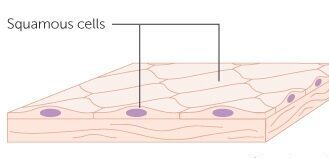The covering or protective tissues in the animal body are epithelial tissues. Epithelium covers most organs and cavities within the body. It
also forms a barrier to keep different body systems separate. The skin, the lining of the mouth, the lining of blood vessels, lung alveoli and kidney tubules are all made of epithelial tissue. Epithelial tissue cells are tightly packed and form a continuous sheet. They have only a small amount of cementing material between them and almost no intercellular spaces.
Obviously, anything entering or leaving the body must cross at least one layer of epithelium. As a result, the permeability of the cells of various epithelia play an important role in regulating the exchange of materials between the body and the external environment and also between different parts of the body. Regardless of the type, all epithelium is usually separated from the underlying tissue by an extracellular fibrous
basement membrane.

Different epithelia show differing structures that correlate with their unique functions. For example, in cells lining blood vessels or lung alveoli, where transportation of substances occurs through a selectively permeable surface, there is a simple flat kind of epithelium. This is called the simple squamous epithelium (squama means scale of skin). Simple squamous epithelial cells are extremely thin and flat and form a delicate
lining. The oesophagus and the lining of the mouth are also covered with squamous epithelium. The skin, which protects the body, is also made of squamous epithelium. Skin epithelial cells are arranged in many layers to prevent wear and tear. Since they are arranged in a pattern of layers, the epithelium is called stratified squamous epithelium.

Where absorption and secretion occur, as in the inner lining of the intestine, tall epithelial cells are present.

This columnar (meaning ‘pillar-like’) epithelium facilitates movement across the epithelial barrier. In the respiratory tract, the columnar epithelial tissue also has cilia, which are hair-like projections on the outer surfaces of epithelial cells. These cilia can move, and their movement pushes the mucus forward to clear it. This type of epithelium is thus ciliated columnar epithelium.

Cuboidal epithelium (with cube-shaped cells) forms the lining of kidney tubules and ducts of salivary glands, where it provides mechanical support. Epithelial cells often acquire additional specialisation as gland cells, which can secrete substances at the epithelial surface. Sometimes a portion of the epithelial tissue folds inward, and a multicellular gland is formed. This is glandular epithelium.

